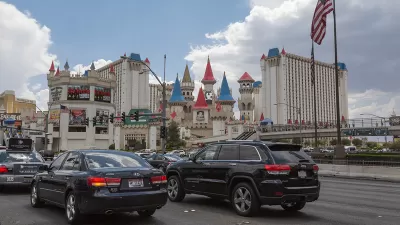An August 17 press release from the National Safety Council indicates the United States is on track to exceed 40,000 road deaths this year, the highest since 2007. A January NPR report links the spike to decreased gas prices.
"Traffic fatalities are up 14% so far in 2015, according to new data from the nonprofit National Safety Council," which tracks nationwide fatalities, reports CNN. "That puts the year on pace to be the deadliest for drivers since 2007."
There were more than 18,600 motor-vehicle deaths from January through June this year, compared to 16,400 deaths in the first six months of 2014.
The NSC partly attributes the jump in fatalities to the fact that people are driving more because gas is cheaper. On average, gas prices are down 30% from 2014.
The relationship between cheap gas and increased traffic fatalities was the topic of a "hidden brain" National Public Radio report (listen here) by science correspondent Shankar Vedantam. Increased vehicle miles traveled (VMT) is the chief culprit, be it from cheap gas, improved economy, or both.
I came by this analysis of the relationship between gasoline prices and road fatalities in 144 countries. And what it finds is that higher gas prices are associated with fewer fatalities. Lower gas prices are associated with a larger number of traffic deaths.
"So, Shankar, why is this happening?" asks David Greene, host of NPR's Morning Edition.
"The biggest factor of course is that people simply drive a lot less when gas prices are high," responds Vedantam.
Kim Bellware of the The Huffington Post wrote about the research of "South Dakota State University sociology professor Guangqing Chi, who analyzes the relationship between gas prices and road fatalities" and was also interviewed by Vedantam on NPR.
"A $2 drop in gasoline price can translate into about 9,000 road fatalities a year in the U.S," Chi said on NPR's Morning Edition.
NPR science correspondent Shankar Vedantam said his "jaw dropped" when he heard the "scary" number. A more conservative calculation based on Chi's research translates into 3,000 more road deaths per year, Vedantam said.
"If the trend continues, traffic deaths this year could exceed 40,000 for the first time since 2007, when there were nearly 44,000 deaths, said Deborah A.P. Hersman, president of the National Safety Council (and former chair of the National Transportation Safety Board ), reports The Oregonian in an article focused on a 32% increase in Oregon traffic deaths from this date last year.
The other factor causing an increase in fatalities is the improved economy. "There are also more commuters on the road heading to work, since the U.S. economy has been steadily adding jobs throughout 2015," notes CNN.
Back to NPR: "Is there something that government officials should be thinking about doing to raise awareness of this problem?" asks Greene.
"Well, David, the obvious answer is that higher gas prices are probably going to save lives," responds Vedantam. "Chi himself thinks that we should maybe impose gasoline taxes, raise the price of gasoline - and that would not make consumers happy - but it probably would save lives."

Alabama: Trump Terminates Settlements for Black Communities Harmed By Raw Sewage
Trump deemed the landmark civil rights agreement “illegal DEI and environmental justice policy.”

Planetizen Federal Action Tracker
A weekly monitor of how Trump’s orders and actions are impacting planners and planning in America.

Why Should We Subsidize Public Transportation?
Many public transit agencies face financial stress due to rising costs, declining fare revenue, and declining subsidies. Transit advocates must provide a strong business case for increasing public transit funding.

Understanding Road Diets
An explainer from Momentum highlights the advantages of reducing vehicle lanes in favor of more bike, transit, and pedestrian infrastructure.

New California Law Regulates Warehouse Pollution
A new law tightens building and emissions regulations for large distribution warehouses to mitigate air pollution and traffic in surrounding communities.

Phoenix Announces Opening Date for Light Rail Extension
The South Central extension will connect South Phoenix to downtown and other major hubs starting on June 7.
Urban Design for Planners 1: Software Tools
This six-course series explores essential urban design concepts using open source software and equips planners with the tools they need to participate fully in the urban design process.
Planning for Universal Design
Learn the tools for implementing Universal Design in planning regulations.
Caltrans
Smith Gee Studio
Institute for Housing and Urban Development Studies (IHS)
City of Grandview
Harvard GSD Executive Education
Toledo-Lucas County Plan Commissions
Salt Lake City
NYU Wagner Graduate School of Public Service




























